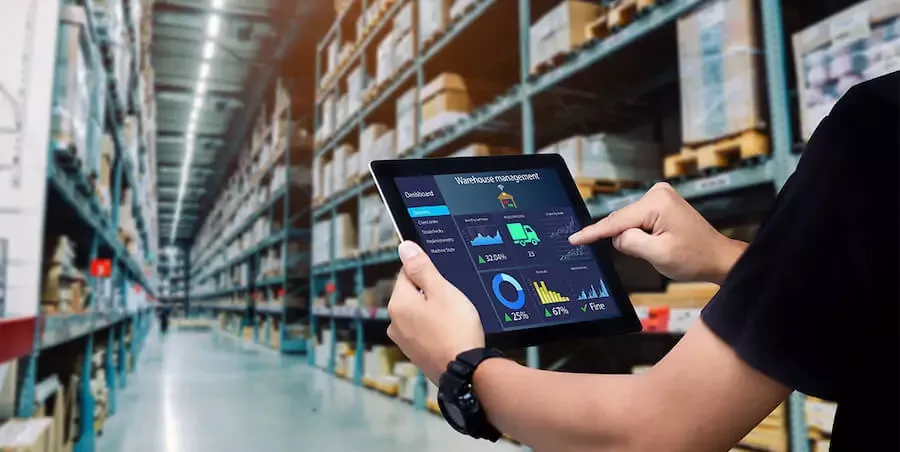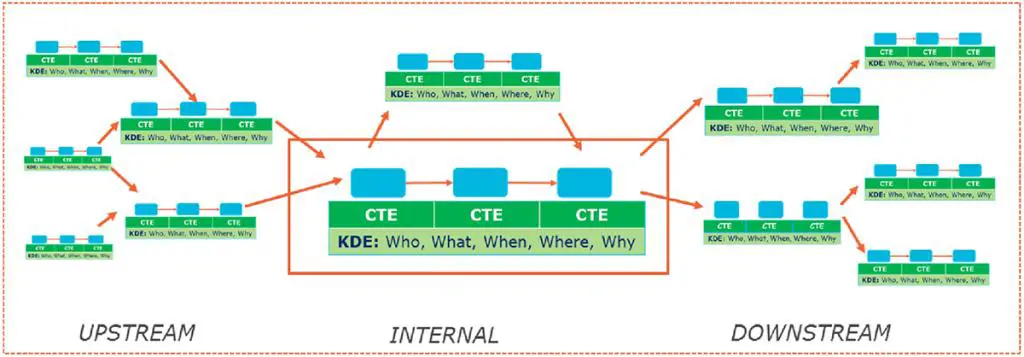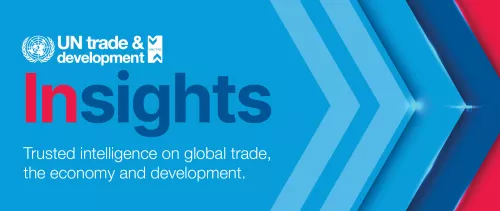
© Shutterstock | Worker hands holding tablet on blurred warehouse as background
Enhanced information exchange among Supply Chain stakeholders improves operations resulting in many benefits toward the United Nations Sustainable Development Goals
Global traceability covering “from farm to fork”, “from cow to consumer”, “from catch to kitchen”, “from field to fashion product”[i] or any other end-to-end supply chain has always been important. Today, it has become a key driver for businesses in all sectors due to increasing requirements (regulatory, consumer and others).

COVID-19 has created the most severe impact on supply chains in recent history and caused one of the biggest disruptions in human history. A recent study by the United Nations showed that the impact of COVID-19 to virtually all of the Sustainable Development Goals was in alignment with the findings of an international survey performed by Chartered Institute of Procurement and Supply. They found that more than 86% of supply chains had been impacted by the COVID-19 pandemic. [ii] Digital Transformation in Supply Chains, with the adoption of smart technologies such as real-time tracking and tracing technologies, can enhance sustainability, transparency, visibility, precision, control, and resilience aspects of supply chain partners.
Digitalization is an important instrument in realizing a reliable and sustainable future transport system and supply of goods [iii] . Digitalization of shipment and consignment data is a key building block and a required assumption in universal (real-time) track and trace capabilities that will enable digital ecosystems (digital supply chains) to flourish, overcoming current logistics inefficiencies and gaps in information flows. Organisations will have full visibility and sovereignty of their supply chains and of fully interconnected logistics networks so that transport assets and resources are used for optimum efficiency.
UN/CEFACT has now released its new Business Requirements Specification (BRS) for “Integrated Track and Trace for Multi-Modal Transportation”. The scope covers track and trace from one seller to one buyer. Although this does not cover the end-to-end supply chain, it does represent a major step forward in achieving truly global traceability in each step of the supply chain.
Background
Within the context of this article, the Supply Chain is a network of facilities that procure raw materials, transform them into intermediate goods and then delivers final products to customers through a distribution system. It refers to the network of organizations, people, activities, information, and resources involved in delivering a product or service to a consumer. Global Traceability aims to provide end-to-end insight into the origin of materials, processing history, distribution and location of materials and products (semi-finished and finished) up to delivery and also in the after-market part of the product life cycle.
Customers and consumers especially are increasingly asking for information that requires global traceability (e.g., was the palm oil used in their food sourced from a farm that manages its business in a sustainable way). Businesses are also asking for ever more traceability information from their suppliers upstream in the supply chain. This is often driven by existing and emerging regulations.
The European Commission adopted the Sustainable Product Regulation on 30 March 2022. This draft regulation includes the EU digital product passport. It applies to any physical good, including components and intermediates products, introduced into the EU market or put into service. This definition includes products manufactured in Europe or exported into the EU. In this sense, the regulation impacts global trade.
The German Supply Chain Act (LkSG) was passed in June 2021. This regulation carries new rules to ensure companies doing business in Germany meet the standards set out in United Nations (UN) Guiding Principles on Business and Human Rights and the OECD Guidelines for Multinational Enterprises.
Similar regulations are also emerging in other countries, such as:
- The Netherlands Child Labour Due Diligence Law
- Norway Transparency Act
- Switzerland Due Diligence Law
- France Duty of Vigilance Act
Motivated by factors such as governmental regulations, operational efficiency standards, competitive pressures, and heightened customer expectations, both public and private organizations are searching for mechanisms to reduce risks by gaining data-driven visibility into the physical location, condition, and context of their products and assets.
Problem statement
Most of the increasing requirements mentioned above are driven by various UN Sustainable Development Goals. It is to be expected that more and more regulations will require stakeholders in supply chains to make these SDGs part of their daily operations. Therefore, there is an urgent and compelling need for traceability systems.
A traceability system (TS) would record and allow us to follow the trail of production, as products, parts, materials and services originate from suppliers and are processed and ultimately distributed as final products and services.

Figure 1. Traceability across Supply Chains, GS1.
Unfortunately, existing Traceability Systems do not provide a comprehensive view of the supply chain. The image above looks at the traceability events within a single organization only. Many gaps still exist in the flow of information among stakeholders. ‘Transport and Logistics’ has been among the biggest gaps. Supply chain managers receive little or no relevant information about the product during transportation. That may now change as a result of the new BRS for “Integrated Track and Trace for Multi-Modal Transportation”.
How does the new UN/CEFACT BRS help?
Even though this particular UN/CEFACT publication is not focused on Sustainability, it was incorporated by design. The primary aim of the Track and Trace approach outlined in the BRS is to respond to the question: “Where are my Goods?”. This very closely ties in with the insights into distribution and location of products, that is at the heart of global traceability. The BRS links the Trade view (of Sellers and Buyers of Goods) with the Transport view, which was sorely lacking before.
Transport and Logistics is an industry consisting of process-oriented businesses that focus on managing the flow of resources, both material and abstract, from the origin and/or destination (in the case of reverse logistics). Logistics processes are often complex due to varied modes of transportation (Multi-Modal) and multiple parties involved[iv]. The UN/CEFACT BRS connects the dots across all stakeholders in all modes of transport, all types of goods and sectors as well as all modes of transport.
Supply chain management and complex logistics compel constant monitoring and handling of ever more complex and evolving supply chains. Therefore, it is crucial to track and trace goods, for ensuring the control and management of the different logistics operations. Rather than proposing any new standards to enable this constant monitoring, the BRS describes an approach how stakeholders in Transport and Logistics (T&L) networks may define and design track and trace solutions based on existing global data standards that enable digitalization of T&L activities and associated information flows. It leverages ISO, UN/CEFACT and GS1 standards among others, in association with emerging technological solutions.
Leveraging existing standards requires less time, resources, effort and investment to achieve more business benefits more quickly because the same standards are also used in other contexts, such as the latest UN/CEFACT documents on Textiles and Leather and the upcoming White Paper on Product Conformity Information Exchanges. The latter White Paper may be of particular interest because frequently, information exchanged for traceability may need to be supported by independent attestation that the information is accurate and does indeed relate to the goods/product at hand.
The most beneficial, real-time supply chain data is now most likely generated and delivered by some form of tracking technology, adopted by actors, facilitators in the frameworks of Multi-Modal Transport. Whenever such data is captured, the approach outlined in the BRS can help stakeholders identify if and when such data would need to be exchanged among stakeholders to achieve the minimum required track and trace objectives and by extension enable much better global traceability for products.
Conclusion
Many supply chain-related issues arise due to the lack of sharing information between the stakeholders in the supply chain. The Transport and Logistics sector has had a major challenge in obtaining reliable and timely information to be able to establish truly global traceability systems for products.
Supply chain practitioners state that sustainability in all its dimensions as a trend, is constantly increasing in importance, both driven from customers as well as public sector; the “social and environmental dimensions of Digital Transformation in supply chain management and logistics are expected to have less impact than the economical dimension”.
The future of supply chain and logistics is hopeful, with the introduction, adoption and evolution of digital transformation technologies, to propel overall sustainability.
The new UN/CEFACT BRS finally enables stakeholders in supply chains to get track and trace information regarding transport and logistics from the operators in T&L in a standardised and consistent fashion regardless of which step in the end-to-end supply the goods (e.g., raw materials, components, [sub]systems, semi-finished or finished product) are being transported.
Using the approach outlined in the BRS, stakeholders may identify what information to exchange and when to achieve the minimum-required track and trace objectives and by extension, enable much better global traceability for products.
The ability to track products and assets (in real-time) throughout the value chain has become increasingly important in a wide range of industries and it would fundamentally transform supply chain management. Organizations will have full visibility and sovereignty of their supply chains as well as of fully interconnected logistics networks so that assets and resources are used for optimum efficiency. Greater efficiency and optimization in supply chain management will facilitate faster adoption of SDGs in compliance with current and future regulations.
The BRS may be downloaded from UNECE.
Note. UN/CEFACT experts participate as independent volunteer experts in their own right, without representing any special interests of their countries or institutions. The opinions expressed herein are the authors’; they are not necessarily those of their employers or organisations in which they are active.
[i] UN/CEFACT released 2 BRS for Traceability and Transparency in Textile and Leather; https://unece.org/trade/uncefact/brs
[ii] Remko, V.H. (2020), “Research opportunities for a more resilient post-COVID-19 supply chain – closing the gap between research findings and industry practice”, International Journal of Operations and Production Management, Vol. 40 No. 4, pp. 341-355. Source Information: Emerald. https://www.emerald.com/insight/content/doi/10.1108/IJOPM-03-2020-0165/full/html
[iii] PwC (2016). The era of digitized trucking: Transforming the logistics value chain. PwC. Source Information: Strategy&. https://www.strategyand.pwc.com/gx/en/insights/2016/era-of-digitized-trucking.html
[iv] M’hand, M. A., Boulmakoul, A., Badir, H., & Lbath, A. (2019). A scalable real-time tracking and monitoring architecture for logistics and transport in RoRo terminals. Procedia Computer Science, 151, 218-225. Source Information: ScienceDirect. https://www.sciencedirect.com/science/article/pii/S1877050919304946


